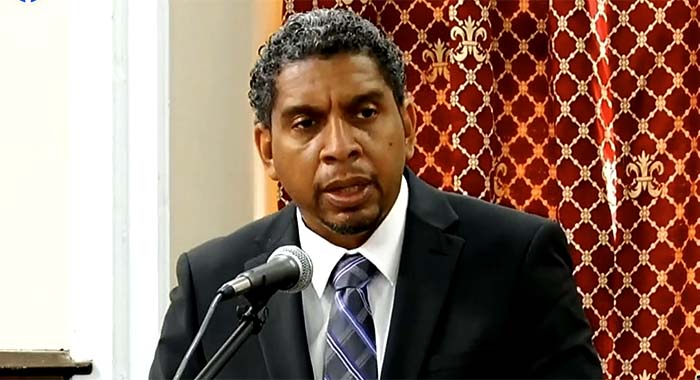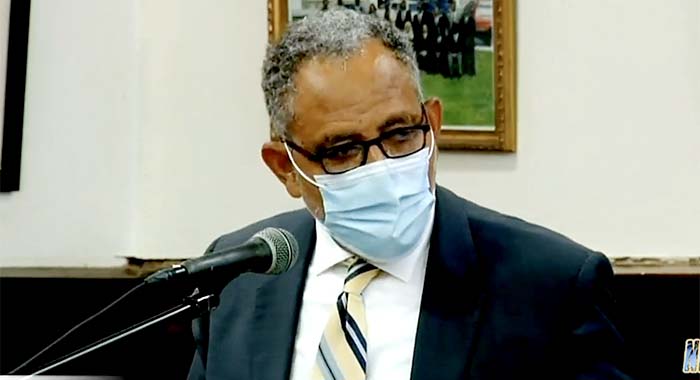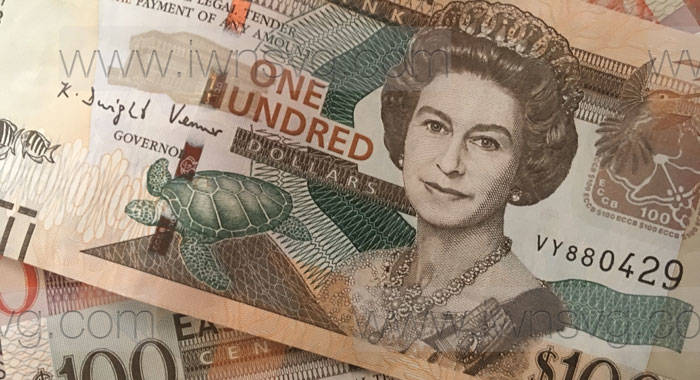The national debt of St. Vincent and the Grenadines, as at Sept. 30, 2021, was almost as big as its gross domestic product (GDP) — the value of goods and services produced in the country in a year.
Minister of Finance, Camillo Gonsalves told the Estimates Debate on Tuesday, that the EC$2,083,671,265 debt is a 13.% increase over the total disbursed outstanding public debt for the comparative period in 2020.
Speaking in the same debate, Leader of the Opposition, Godwin Friday, said that the debt situation now means that the space that the government has for borrowing is extremely limited.
The country finds itself in a situation where 42 cents from every dollar of current revenue goes to pay the national debt, the opposition leader said.
Meanwhile, the finance minister told lawmakers that the total domestic debt, which amounted to EC$525.4 million, as at the end of September 2021, decreased by 1.6% or EC$8.7 million when compared with the domestic debt for the same period in 2020.
The external debt for the period stood at EC$1.56 billion, an increase of 19.2% or EC$251 million when compared to the same period.
Regarding the domestic debt portfolio, over the period, the balance outstanding on overdrafts offered by the public sector, increased by EC$800,000 or 1.6%.
The local loans portfolio fell by 1.4%, or EC$1.5 million, as a result of amortisation on a number of loans during this period, including the Agricultural Input Warehouse loan, which was trepaid over that period, Gonsalves told lawmakers.
At the same time, total government bonds and notes issued and outstanding decreased marginally by EC$100,000.

As at the end of September 2021, the increase in the external debt was 251.3 million year-on-year.
The main drivers accounting for this change in external indebtedness of the government are the supplemental financing of the Second Reform and Resilience Development Policy Credit of EC$135 million, the second Fiscal Reform and Resilience Development Policy Credit — the Catastrophe Deferred Drawdown Option (Cat DDO) of EC$54 million , the Caribbean Regional Digital Transformation Programme — a EC$3.9 million; the OECS Medium and Small Enterprises Guarantee Facility Project — EC$2.7 million; the Regional Disaster Vulnerability Reduction Project — EC$27.3 million; the Human Development Service Delivery Project –$5.9 million.
The finance minister said that notwithstanding this, net repayments were recorded on a number of external loans during the period.
Some of the more significant ones are EC$1.3 million repaid on a number of EIB loans; EC$6.8 million repaid on loans from Taiwan; EC$1.9 million paid on loans owed to the ALBA bank; EC$1.6 million paid on loans from the CARICOM Development Fund; and, EC$11.6 million paid to bondholders.
“Total debt service for 2021 is estimated at EC$271.9 million, or 41.9% of current revenue. The debt service requirements are made up of interest payments of $74.1 million, amortisation of $182.9 million,” the finance minister said.
Debt 98.1% of GDP
Meanwhile, the opposition leader raised the issue of the national debt as he highlighted the fact that the financing of the 2022 capital budget of EC$651.8 million includes Other Receipts of EC$265.4 million.
Friday noted that in the Estimates all the borrowings are already explained and accounted for.
“So it’s not expected that that category, ‘Other Receipts’ can be made up by any other loans, because those are already specified here.”
“Any debt has to be paid because if they don’t, the consequences are even more grave. It becomes more expensive to borrow; you get a bad name. Maybe even some disbursements may be affected. So, we know that the debt has to be paid.
“And we have a situation where 42 cents of every dollar raised in current revenue goes to it. We also have a situation where the debt to GDP ratio has climbed from 85% last year — it used to be down in the 70s — to 98.1% of GDP. So, the debt is pretty much the size of our economy.
“… the point is, the situation that we have here is one that is untenable. … if you have 41-42 cents on every dollar paying debt, you have a debt to GDP ratio of 98%, you don’t even need a document from anybody to tell you that you’re in serious problem. That is evident, by itself.
“What this tells me is that there’s very little room for the government to be borrowing anymore. And so where are the funds gonna come from? Where’s the plan? We need a plan for productive investments to support local businesses, farmers to get the economy going, again, creating jobs, and then tax revenue for the government.”

The opposition leader said that the borrowing situation “looks very much foreclosed” and asked whether the money in the “Other Receipts” category is going to come from taxes.
“The people of this country can’t afford any more taxes. They have been long suffering over the past year and a half, two years. And some just simply have been suffering. They can’t afford any new taxes.
“… But what is evident is that the estimates, as presented as the, if you like, architecture of the government’s economic thrust for the next year doesn’t point to anything that is positive, transformative, or suggesting that there is going to be some serious movement or effort to move the economy forward.”
The opposition leader said that around the world, including the largest economy, the United States, governments are using the coronavirus pandemic as an opportunity to reset their economies.
This involves thinking of ways to do things differently and better.
“It requires investment; it requires grey matter — thinking about it as to what is feasible and then pointing in a direction that everybody can see it and either buy into or can offer critical suggestions as to ways in which it can improve,” the opposition leader told Parliament.
He, however, said that it seems to him that the Estimates contains “… the same sort of puffery and inflation of the estimate to make it look good”.
Friday said that the finance minister knows that the situation “is getting out of whack,” adding, “it is one thing when it’s (Other Receipts) $35 million or $55 million, but $265 million?”
He further said there was an “explicit admission” that the Others Receipts is going in the wrong direction, as the projection for 2022 is EC$265 million this year compared to EC$258 million last year.
“It was less the year before and so forth. So it’s going up. But only in the projections does it actually go down. So you see that for 2023 is projected to be $247 million.”
Friday, however, noted that “Other Receipts” is projected to decline to EC$212 million in 2024.
“That doesn’t happen in reality, because every year it’s been going up and up and up. I’ve been in this house long enough to notice. So that is essentially an admission that it ought to be coming down,” siad Friday, who has been a parliamentarian since 2001.
“They need to phase it out or they need to find — maybe they intend to find other money elsewhere to reduce that category. But we are not going to get any further ahead until we acknowledge that this is a problem and the minister comes upfront and explain to people what exactly he intends to do over the course of the next year with the budget.”
Friday further noted that the EC$265 million is intended to be raised from domestic receipts.
“So, no money coming from abroad. That’s what’s said in the estimates themselves. So, you have to get it from internal sources. Makes it even more doubtful, sceptical, begs credulity that those funds can be raised domestically.”







You see sooner or later all the bonds and treasury note payments will catch up when people stop buying the revolving offerings, at that time we will begin defaulting on loans and repayments. That moment is not far away.
Can anyone say how all the aid money we have received has been spent?
The Toxic Duo a recipe for financial ruin